
How DNA is copied (replication). How information in DNA can be used to make a protein.
- Subject:
- Biology
- Genetics
- Life Science
- Material Type:
- Lesson
- Provider:
- Khan Academy
- Provider Set:
- Khan Academy
- Author:
- Sal Khan
- Date Added:
- 12/10/2014

How DNA is copied (replication). How information in DNA can be used to make a protein.
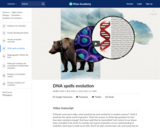
DNA weaves together the tapestry of life on Earth. It mutates, which can lead to variation among organisms. Watch how natural selection relies on DNA to mold organisms to suit their environments.
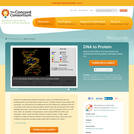
Explore the relationship between the genetic code on the DNA strand and the resulting protein and rudimentary shape it forms. Through models of transcription and translation, you will discover this relationship and the resilience to mutations built into our genetic code. Start by exploring DNA's double helix with an interactive 3D model. Highlight base pairs, look at one or both strands, and turn hydrogen bonds on or off. Next, watch an animation of transcription, which creates RNA from DNA, and translation, which 'reads' the RNA codons to create a protein.

Data Carpentry lesson to learn how to use command-line tools to perform quality control, align reads to a reference genome, and identify and visualize between-sample variation. A lot of genomics analysis is done using command-line tools for three reasons: 1) you will often be working with a large number of files, and working through the command-line rather than through a graphical user interface (GUI) allows you to automate repetitive tasks, 2) you will often need more compute power than is available on your personal computer, and connecting to and interacting with remote computers requires a command-line interface, and 3) you will often need to customize your analyses, and command-line tools often enable more customization than the corresponding GUI tools (if in fact a GUI tool even exists). In a previous lesson, you learned how to use the bash shell to interact with your computer through a command line interface. In this lesson, you will be applying this new knowledge to carry out a common genomics workflow - identifying variants among sequencing samples taken from multiple individuals within a population. We will be starting with a set of sequenced reads (.fastq files), performing some quality control steps, aligning those reads to a reference genome, and ending by identifying and visualizing variations among these samples. As you progress through this lesson, keep in mind that, even if you aren’t going to be doing this same workflow in your research, you will be learning some very important lessons about using command-line bioinformatic tools. What you learn here will enable you to use a variety of bioinformatic tools with confidence and greatly enhance your research efficiency and productivity.

In this video module, students learn how scientists use genetic information from dogs to find out which gene (out of all 20,000 dog genes) is associated with any specific trait or disease of interest. This method involves comparing hundreds of dogs with the trait to hundreds of dogs not displaying the trait, and examining which position on the dog DNA is correlated with the trait (i.e. has one DNA sequence in dogs with the trait but another DNA sequence in dogs not displaying the trait). Students will also learn something about the history of dog breeds and how this history helps us find genes.
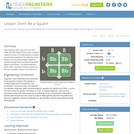
After watching video clips from the Harry Potter and the Goblet of Fire movie, students explore the use of Punnett squares to predict genetic trait inheritance. The objective of this lesson is to articulate concepts related to genetics through direct immersive interaction based on the theme, The Science Behind Harry Potter. Students' interest is piqued by the use of popular culture in the classroom.

Students will construct a model of a dragon based on traits inherited from the parent dragons. This activity demonstrates the inheritance of dominant and recessive traits, codominance, and incomplete dominance. Students will use Punnett Squares to predict genotypic and phenotypic ratios of the dragon population in the class. This project could serve as a culminating activity for Genetics and the Inheritance of traits. This activity was adapted from Alabama Science in Motion. This lesson results from a collaboration between the Alabama State Department of Education and ASTA.
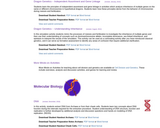
Students learn the principles of independent assortment and gene linkage in activities which analyze inheritance of multiple genes on the same or different chromosomes in hypothetical dragons. Students learn how these principles derive from the behavior of chromosomes during meiosis and fertilization.
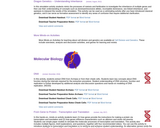
In this simulation activity students mimic the processes of meiosis and fertilization to investigate the inheritance of multiple genes and then use their understanding of concepts such as dominant/recessive alleles, incomplete dominance, sex-linked inheritance, and epistasis to interpret the results of the simulation. This activity can be used as a culminating activity after you have introduced classical genetics, and it can serve as formative assessment to identify any areas of confusion that require additional clarification.
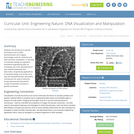
Students are introduced to genetic techniques such as DNA electrophoresis and imaging technologies used for molecular and DNA structure visualization. In the field of molecular biology and genetics, biomedical engineering plays an increasing role in the development of new medical treatments and discoveries. Engineering applications of nanotechnology such as lab-on-a-chip and deoxyribonucleic acid (DNA) microarrays are used to study the human genome and decode the complex interactions involved in genetic processes.
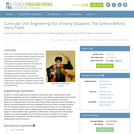
Under the "The Science Behind Harry Potter" theme, a succession of diverse complex scientific topics are presented to students through direct immersive interaction. Student interest is piqued by the incorporation of popular culture into the classroom via a series of interactive, hands-on Harry Potter/movie-themed lessons and activities. They learn about the basics of acid/base chemistry (invisible ink), genetics and trait prediction (parseltongue trait in families), and force and projectile motion (motion of the thrown remembrall). In each lesson and activity, students are also made aware of the engineering connections to these fields of scientific study.
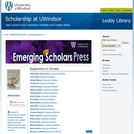
Epigenetics - our epigenome - controls how our genes behave without altering their sequence. Just about everything affects it, from nutrition, drugs, and toxins to child rearing, culture, and society. Many diseases, from obesity to addiction to cancer, can be linked to epigenetic modifications. Furthermore, throughout development and life, from conception to death, the exposures you have will not only affect your own epigenome, but potentially also your child’s, and your grandchild’s. This rapidly expanding field of biological, physiological, sociological, and psychological research could be key to discovering why, and more importantly how, we are the way we are.
Epigenetics has consequences for medicine, pregnancy, childcare, law and how we live on an everyday basis. This book will provide a comprehensive introduction to the mechanisms and real-life consequences of epigenetics, and will arm the reader with the knowledge necessary to make informed decisions about the future of epigenetics in modern society. This is a call for serious consideration about the effects of epigenetics on society.

This resource, provided by Wisconsin Fast Plants and CurrikiStudio, contains a set of six different learning activities that can be implemented in classrooms to teach natural selection. Organized in playlists, these interactive lessons guide students through understanding and applying knowledge of natural selection. The specific playlists and modules include: Population Pre-think for discussion: Factors that affect traits in populations Checking for understanding: Investigating Change Over Time in Populations Exploring Selection Models Looking for Evidence in Data Selection Models Genetics Review The Language of Genetics Looking for Patterns and Analyzing Population Data
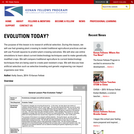
The purpose of this lesson is to research artificial selection. During this lesson, we will use fast growing plant crossing to model traditional agricultural practices and we will use Punnett squares to predict plant crossing outcomes. We will also use online simulations to learn about current biotechnology techniques used to make genetically modified crops. We will compare traditional agriculture to current biotechnology techniques that are being used to create pest resistant crops. We will discuss how artificial selection such as selective breeding and genetic engineering can impact organisms over time.
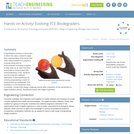
A hypothetical scenario is introduced in which the class is asked to apply their understanding of the forces that drive natural selection to prepare a proposal along with an environmental consulting company to help clean up an area near their school that is contaminated with trichloroethylene (TCE). Students use the Avida-ED software application to test hypotheses for evolving (engineering) a strain of bacteria that can biodegrade TCE, resulting in a non-hazardous clean-up solution. Conduct this design challenge activity after completion of the introduction to digital evolution activity, Studying Evolution with Digital Organisms.

Example punnet square for sex-linked recessive trait.

Download this complete and coherently designed, middle school level unit to teach fundamental concepts that underpin the theory of evolution. The unit was collaboratively designed by teachers, college faculty & staff, and the Fast Plants Program at UW-Madison to support student-centered inquiry-based learning. The unit's storyline is underpinned by the 5E model. Like three dimensional learning as described by the Next Generation Science Standards, this unit is designed for students to learn academic content by working like scientists: making observations, asking questions, doing further investigations to explore and explain natural phenomena, and communicating results based on evidence. Immersion Units are intended to support teachers in building a learning culture in their classrooms to sustain students’ enthusiasm for engaging in scientific habits of thinking while learning rigorous science content.

Why do some organisms go extinct? What impact do humans play in the extinction of animals? What can we do about it? If something is extinct is it truly gone forever? These are some of the major questions that conservation biologists are currently asking. Extinction is when a species no longer has any living members in the wild or in captivity. Extinction can happen for a number of reasons including habitat loss, overhunting, and climate change. Mass extinction is widespread extinction across many species. Right now, we are experiencing the sixth mass extinction event on Earth and it has been primarily caused human activity. Conservation biologists have been hard at work coming up with solutions to prevent extinction of organisms at risk, however, extinction still occurs. But does it have to be permanent? This module walks students through the major processes that cause extinction, what strategies conservation has used so far to prevent extinction, what de-extinction is, and what consequences de-extinction may have through the use of videos, research, and a class debate.
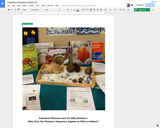
Studying the Fibonacci Sequence is our entry point for studying Heredity: Inheritance and variation of traits.

Sign up for a free account on the Gizmo website (https://www.explorelearning.com/index.cfm?method=Controller.dspFreeAccount) for free access to two simulations that were collaboratively developed by the teams at Explore Learning and the Wisconsin Fast Plants Program of the University of Wisconsin-Madison. These simulations replace those previously available on our website that were developed nearly two decades ago and no longer function on modern operating systems. Fast Plants Gizmos were created as a collaboration between ExploreLearning and the Wisconsin Fast Plants Program of the University of Wisconsin-Madison. They weredesigned to support many of the experiments that students can do using Fast Plants seeds and plants. By using these Gizmos in combination with firsthand experiences growing Fast Plants, students can compare simulated growth, development and reproduction with observations of living Fast Plants. In addition, the Gizmos genetic simulation makes it possible for students to gather data from a significantly larger plant population than is typically grown in classrooms. These Gizmos also stand alone, supporting topics both in plant life cycles and Mendelian genetics and can be used by any student. Simulation, Simulations, Genetics, Inheritance